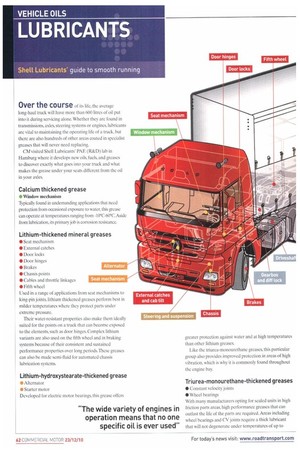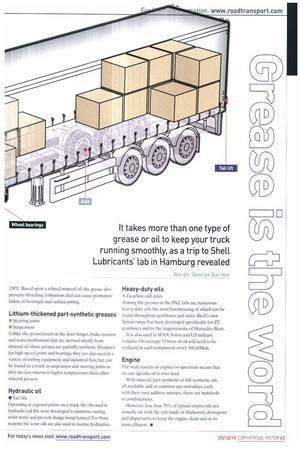LUBRICANTS
Page 62

Page 63

If you've noticed an error in this article please click here to report it so we can fix it.
Shell Lubricants' guide to smooth running
Over the course of its life, the average long-haul truck will have more than 600 litres of oil put into it during servicing alone. Whether they are found in transmissions, axles, steering systems or engines, lubricants are vital to maintaining the operating life of a truck, but there are also hundreds of other areas coated in specialist greases that will never need replacing.
CM visited Shell Lubricants' PAE (R&D) lab in Hamburg where it develops new oils, fuels, and greases to discover exactly what goes into your truck and what makes the grease under your seats different from the oil in your axles.
Calcium thickened grease • Window mechanism Typically found in undemanding applications that need protection from occasional exposure to water, this grease can operate at temperatures ranging from -10°C-60°C. Aside from lubrication, its primary job is corrosion resistance.
Lithium-thickened mineral greases • Seat mechanism • External catches • Door locks • Door hinges • Brakes • Chassis points • Cables and throttle linkages • Fifth wheel Used in a range of applications from seat mechanisms to king-pin joints, lithium thickened greases perform best in milder temperatures where they protect parts under extreme pressure.
Their water-resistant properties also make them ideally suited for the points on a truck that can become exposed to the elements, such as door hinges. Complex lithium variants are also used on the fifth wheel and in braking systems because of their consistent and sustained performance properties over long periods. These greases can also be made semi-fluid for automated chassis lubrication systems.
Lithium-hydroxystearate-thickened grease • Alternator • Starter motor Developed for electric motor bearings, this grease offers greater protection against water and at high temperatures than other lithium greases.
Like the triurea-monourethane greases, this particular group also provides improved protection in areas of high vibration, which is why it is commonly found throughout the engine bay Triurea-monourethane-thickened greases • Constant velocity joints • Wheel bearings With many manufacturers opting for sealed units in high friction parts areas, high performance greases that can outlast the life of the parts are required. Areas including wheel bearings and CV joints require a thick lubricant that will not degenerate under temperatures of up to 150°C. Based upon a refined mineral oil, the grease also prevents brinelling (vibrations that can cause premature failure in bearings) and surface pitting.
Lithium-thickened part-synthetic greases • Steering joints • Suspension Unlike the greases used on the door hinges, brake systems and seats mechanisms that are derived wholly from mineral oil, these greases are partially synthetic. Designed for high-speed joints and bearings, they are also used in a variety of tooling equipment and industrial fans, but can be found on a truck in suspension and steering joints as they are less viscous at higher temperatures than other mineral greases.
Hydraulic oil • Tail lifts Operating at exposed points on a truck, the oils used in hydraulic tail lifts were developed to minimise rusting, resist water and prevent sludge being formed. For those reasons, the same oils are also used in marine hydraulics. Heavy-duty oils Gearbox and axles Among the greases in the PAE labs are numerous heavy-duty oils, the most hardwearing of which can be found throughout gearboxes and axles. Shell's own Spirax range has been developed specifically for ZF gearboxes and to the requirements of Mercedes-Benz.
It is also used in MAN, Volvo and US military vehicles. On average 15 litres of oil will need to be replaced in each component every 160,000km.
Engine The wide variety of engines in operation means that no one specific oil is ever used.
With mineral, part synthetic or full synthetic oils all available and in common use nowadays, each with their own additive mixture, there are hundreds of combinations, However, less than 70% of typical engine oils are actually oil, with the rest made of thickeners, detergents and dispersants, to keep the engine clean and at its most efficient. •
































































































































